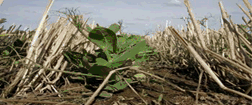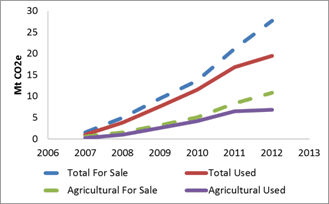| | New Potential Continues to Develop for Carbon Offset Sales by Farmers and Aggregators
When greenhouse gas (GHG) emissions are voluntarily lowered by improved management activities, the end result is fewer GHGs in the atmosphere. Activities that qualify as offsets are real - above and beyond “business as usual”, measureable - based on sound science, and verifiable - by an independent third party..
From 2007 to 2012, agricultural offsets in Alberta:
• Voluntarily lowered carbon levels as much as taking 2 million cars off the road
• Represented 1 in 3 tonnes of reductions by regulated emitters
• Generated close to $132 M for farmers and aggregators (assuming $12.00 / T CO2e) |
The Government of Alberta (GOA) has approved protocols that apply internationally recognized International Standards Organization (ISO) principles to establish carbon offsets. The protocols link science-based emission measurements with verifiable records of management improvements that go beyond common practices. Offsets can be bought by regulated emitters as one of four options to meet reduction requirements under Alberta’s pioneering Specified Gas Emitters Regulation (2007). Close to one-third of all GOA approved offset protocols relate to lowering the carbon footprint of agricultural management.
Agricultural offsets can be created from management improvements that either reduce GHG emissions, such as by managing livestock, manure or energy, or remove GHG emissions from the atmosphere, such as increasing carbon storage in soil. Agricultural offsets represent an important “bio-bridge” until future technologies are in place to reduce emissions - while also improving agricultural production efficiencies and adaptation to a changing climate.
The most well-known type of agricultural offset uses the Tillage System Management Protocol to identify amounts of GHG lowered by reduced till and no-till as compared with conventional full tillage crop management. Reductions were based on field research results that showed lower fuel use, lower nitrous oxide emissions and higher levels of soil carbon storage.

Between 2007 and 2012, all types of improvements (including current technologies) that occurred in Alberta lowered GHG emissions by 34 million tonnes (Mt) of carbon dioxide equivalents (CO2e). Close to 58% of this total was achieved voluntarily through carbon offset sales, with 39% from using the Tillage Protocol.
Total volumes of carbon offsets peaked in 2011, before the January 1, 2012 deadline when verification requirements increased to a higher Reasonable Assurance standard. This ended claims of historical offset credits back to 2002. If the current price cap of $15 / T CO2e continues, even lower offset volumes are expected as a result of higher costs of more record keeping and data management requirements.

Source: C3, Alberta Emissions Offset Registry
Close to 11 Mt CO2e of tillage offsets were registered for sale on the Alberta Emissions Offset Registry between 2007 and 2012. Selling prices increased from $6 to $12 / T CO2e in 2007 to $12 to $14/T CO2e in 2012. Assuming $12 / T CO2e, their total value is close to $132 M. This value has been relatively stable and is higher than in voluntary carbon markets, reflecting the high quality of offsets developed to meet regulated GHG reduction requirements. The selling price of offsets is also influenced by the $15 / T CO2e alternative option for regulated emitters to pay into the Climate Change Emissions Management Corporation fund. This fund is dedicated to developing new future technologies to reduce emissions.
In 2011, only 7% of Alberta’s total GHG emissions came from agriculture, yet agricultural offsets represent 39% of all offsets generated, and 27% of total reductions achieved by regulated emitters..
| CARBON OFFSETS ARE IMPORTANT OPPORTUNITIES FOR FARMERS TO PROFIT FROM MANAGEMENT THAT LOWERS THEIR CARBON FOOTPRINT, WHILE IMPROVING EFFICIENCIES, VALUE OF RECORDS, AND LEARNING TO ACCESS NEW ENVIRONMENTAL MARKETS. |
Recent Developments
The Alberta Offset System continues to improve and evolve as protocols approved in 2007 undergo a scheduled 5 year review. Knowledge is improving about ways to document improved management using verifiable records and data management systems. This is needed to reduce risks of errors at the new Reasonable Assurance standard.
At a scheduled five year review, the Tillage Protocol was renamed the Conservation Cropping Protocol and was revised to include:
- More detailed evidence requirements,
- Lower coefficients due to increased adoption of conservation tillage, and
- New opportunity to claim offsets in previously summerfallowed fields.
A newly adopted Biogas protocol registered agricultural offsets in 2011 by replacing GHG emissions from coal-
fired electricity with renewable methane biogas from cattle manure.

On-farm protocol validation studies were conducted in 2012 and 2013 to test verification of types of records and data management systems at Reasonable Assurance. Best Practice Guides and calculators are being prepared to make this knowledge available.
Status of Agricultural Protocols
Approved Protocol / Year
- Biofuels/2014
- Waste Biomass/2014
- Conservation Cropping/2012
- Beef Low Residual Feed Intake/2012
- Renewable Micro-Energy Generation/2013
- Beef Reduced Days on Feed/2011 Beef Reduced Age at Harvest/2011
- Nitrous Oxide Emissions Reductions/2010
- Dairy Cattle/2010
- Wind Powered Electricity/2008
- Biogas/2007
- Energy Efficiency/2007
|
For more information
See www.agriculture.alberta.ca/agcarbonoffsets
Email: Sheilah.Nolan@gov.ab.ca
Call: (780) 310-FARM (3276)
Initiated by Alberta Agriculture and Rural Development, funding for this Canada-Alberta cost-shared project was provided by Agriculture and Agri-Food Canada though the Agricultural Flexibility Fund, as part of Canada’s Economic Action Plan. |
|